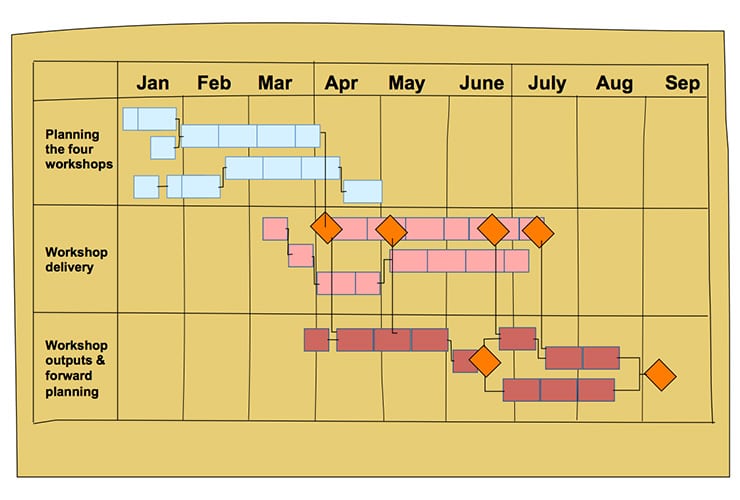Have you ever created an action plan for a project that failed during delivery?
This Brown Paper Planning process is a project plan template that will dramatically increase your chance of success.
Who didn’t do what they said they would? Did commitment of the key stakeholders waver over time?
Project plans (a.k.a. gantt charts) do a great job of communicating but what most people don’t realize is the process you use when you first develop the plan is 10 times more important than the pretty diagram itself.
Brown Paper Planning is a project plan template and process that uses the power of the team to plan a change implementation. At the same time it builds incredible team ownership.
It documents an entire implementation – capturing roles, a timeline and activities shown in “swim lanes”.
It also highlights all milestones, activities, interfaces, decision points and deliverables.
Objective
- To engage your team in planning together all the things that need to be done in order to implement a project or change initiative.
When Would You Use It?
- When it is time to plan how you will deliver the change.
- When you would like to increase buy-in and build ownership of key people in the execution of the plan.
Resources Required
- 1 hour.
- A large piece of brown or blank paper up on a wall (about 2 meters high and perhaps 4 meters long).
- Lots of post-it notes and flip-chart marker pens.
- Space in the room around the paper for people to stand and move.
Process
- Mark out the paper as shown below. There are three things to bear in mind: workstreams; ‘swim-lanes’; and a timeline.

- Your team will first need to identify a number of ‘workstreams’. For convenience, these are ways of dividing up the work of implementing change for planning purposes. They may reflect the responsibilities of several different stakeholders in the project; or they might reflect the different but related functions that make up the change solution (e.g. if your change project was all about moving house, then for planning purposes it might be sensible to think of different streams of work that correspond to the roles and responsibilities of key stakeholders such as: vendor; purchaser; solicitor; estate agent; building society; etc.)
- Each workstream is allocated its own ‘swim lane’ – a row across the brown paper into which all the activities assigned to that workstream are planned.
- The ‘timeline’ reflects the duration of the change project, working backwards right to left, from the end of the project back to the start date. Divide the timeline into equal columns to represent convenient blocks of time or calendar dates – in weeks, months, or school terms, whatever is sensible.
- Start populating the plan by identifying key milestones. These are events, deliverables or decision points that symbolize significant achievements at certain points along the timeline. In the example of moving house, these might be ‘making an accepted offer’; ‘exchange of contracts’; ‘completion’; etc.
- Use square Post-it notes to represent the milestones and orient them in a diamond shape. Write clearly the identity of the milestone in each case.
- In the picture below, there is a series of four milestones in the workshop delivery swim lane – each representing the delivery of one workshop. In the workshop outputs, there are two milestones: an interim draft report and the final report.

- Complete the plan by using post-it notes to represent activities (note that for clarity, each workstream has been assigned a different color). Activities are the work that must be done in order to meet the planned milestones. By using a string of post-it notes you can represent the planned duration of each activity, from start to finish. Use a marker pen to identify the activities with a label.
- Finally, it is advisable to indicate where the start or finish of one activity is dependent on another, by drawing lines between them. These are your dependencies.

- If different people in the team are assigned to a workstream and plan their ‘own’ swim lane, their thinking is then challenged and informed by the planning of other workstreams on which they are interdependent. This results in a far more rigorous plan and builds ownership of the plan going forward.
Secret Sauce
- Don’t plan alone – always use the team by assigning responsibility among team members for each swim lane in the plan.
- Start with milestones – working back from right to left with the final deliverable first, then the subsidiary key milestone events /deliverables.

